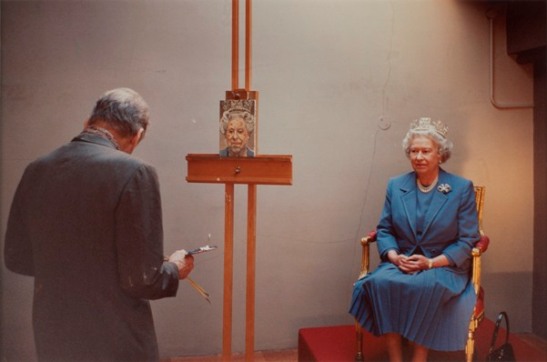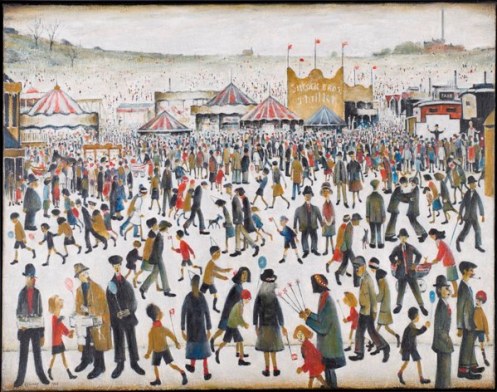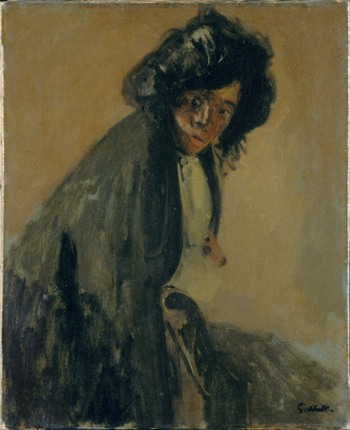Government Art Collection: At Work, Whitechapel Gallery | reviews, news & interviews
Government Art Collection: At Work, Whitechapel Gallery
Government Art Collection: At Work, Whitechapel Gallery
Political figures choose artworks from a rarely seen national collection
It owns almost twice as many artworks as the Arts Council, and two-thirds of its 13,500-strong hoard is on display at any given time, yet it’s a collection the public never usually gets to see. Since its foundation in 1898, the Government Art Collection has been purchasing work by British artists not for the nation, but to hang exclusively in the corridors of power, from Downing Street to the British consulate’s office in Azerbaijan. Perhaps, in these cost-cutting times, it now feels impelled to justify its existence to the taxpayer by giving it a taster of its work – though, in all probability, the British taxpayer was probably unaware of its existence till now.
At Work is the first in a series of five exhibitions at the Whitechapel Gallery showing just a tiny fraction of GAC’s collection. Twenty-five artworks have been selected by seven political figures (future selectors will include Cornelia Parker and Simon Schama). The work was either personally chosen as part of the privilege of office, or else selected by a predecessor and enjoyed by the new incumbent.
The interest essentially lies, of course, not with the works themselves but in the choices made. It’s fun to play a little amateur psychology, after all. And for this reason one might especially enjoy Peter Mandelson’s choices: two queens; a diplomat-artist with close connections to court, and a painted design for the Festival of Britain. Not for Mandelson Nick Clegg’s humdrum thermos flask of tea (painted by David Tindle), but things which speak of grandeur, high office and public life.
 His choice of a 16th-century painting of Elizabeth I, by anon, looks, as one critic pointed out, alarmingly like Margaret Beckett. It’s not a very good painting, but neither is Lucian’s Freud’s of our current Queen: David Dawson’s photograph (pictured right) shows Freud putting the finishing touches to his portrait as Her Majesty sits patiently with hands neatly clasped. Meanwhile, in a statuette of Rubens, a cut-price cast of a plaster version of the original, an English-Brussels connection is established through subject and artist: 18th-century Flemish sculptor John Michael Rysbrack spent most of his adult life in England, while Rubens not only painted for Charles I of England but was given a knighthood for his diplomatic work negotiating peace between England and Spain. Like Mandelson, he was urbane and a smooth political operator.
His choice of a 16th-century painting of Elizabeth I, by anon, looks, as one critic pointed out, alarmingly like Margaret Beckett. It’s not a very good painting, but neither is Lucian’s Freud’s of our current Queen: David Dawson’s photograph (pictured right) shows Freud putting the finishing touches to his portrait as Her Majesty sits patiently with hands neatly clasped. Meanwhile, in a statuette of Rubens, a cut-price cast of a plaster version of the original, an English-Brussels connection is established through subject and artist: 18th-century Flemish sculptor John Michael Rysbrack spent most of his adult life in England, while Rubens not only painted for Charles I of England but was given a knighthood for his diplomatic work negotiating peace between England and Spain. Like Mandelson, he was urbane and a smooth political operator.
Finally, Cecil Stephenson’s painting for a design for the Festival of Britain pays homage to Herbert Morrison, Mandelson’s grandfather and a strong supporter of the 1951 Festival. Ever the consummate politician, it allows Mandelson a defence of his involvement with the Dome in a neat bit of gloss.
Clegg, too, has gone for Dawson’s Freud with Queen. Our Head of State sits in a sparse, gloomy room, but much starker are Zarina Bhimji’s lightbox photograph of a desolate scene of defunct ceiling fans, and Tindle’s eerie picnic with that outsize thermos flask and cup. Might these abject scenes have been chosen post-AV referendum?
 Ed Vaizey shows his Culture Minister credentials by going Britart, choosing two delicate drawings of Margate by new friend and fellow Tory Tracey Emin, and a humorous drawing and text-based work by Michael Landy documenting press reactions to Break Down, Landy’s destructive performance artwork.
Ed Vaizey shows his Culture Minister credentials by going Britart, choosing two delicate drawings of Margate by new friend and fellow Tory Tracey Emin, and a humorous drawing and text-based work by Michael Landy documenting press reactions to Break Down, Landy’s destructive performance artwork.
Alas, Samantha Cameron, an art-school graduate, shows few artistic credentials by going for a rather flat, indifferent painting of the River Thames by forgotten 18th-century artist William Marlow. A Lowry painting of Lancashire Fair, 1946 (pictured above), is brighter, jauntier, but it’s not a particularly memorable Lowry. But perhaps 10 Downing Street isn’t filled with rich pickings from GAC, who are restricted to buying art at low cost.
Paul Boateng’s choices are more interesting and include Bob and Roberta Smith’s street-vendor-like sign declaiming Peas Are The New Beans, 1999 (main picture). He hoped it would raise a smile with the “bean-counters” at the Treasury. Another choice is layered with sexual and racial tensions: Osmund Caine’s 1940 painting of World War Two soldiers crammed into a small dormitory, Spider Hutments, Myechett Barracks, Aldershot, features fully clothed white soldiers and naked black soldiers. GAC’s purchases must fit in with a whole range of diplomatic environments, so Caine’s painting certainly raises a quizzical eyebrow.
 MI6 head and former UK representative at the UN John Sawers and ambassador to Moscow Anne Pringle are the least well known of the selectors, yet their choices prove the most artistically satisfying. Sickert’s La Giuseppina (pictured right), 1903-4, a haunting portrait of a Venetian prostitute, and a 1962 Pop Art painting by Derek Boshier, I Wonder What My Heroes Think of the Space Race – featuring Yuri Gagarin alongside Buddy Holly and Abraham Lincoln – are two of Pringle’s choices. The latter's message seems to be clear: post-Cold War diplomatic relations are in safe hands with me.
MI6 head and former UK representative at the UN John Sawers and ambassador to Moscow Anne Pringle are the least well known of the selectors, yet their choices prove the most artistically satisfying. Sickert’s La Giuseppina (pictured right), 1903-4, a haunting portrait of a Venetian prostitute, and a 1962 Pop Art painting by Derek Boshier, I Wonder What My Heroes Think of the Space Race – featuring Yuri Gagarin alongside Buddy Holly and Abraham Lincoln – are two of Pringle’s choices. The latter's message seems to be clear: post-Cold War diplomatic relations are in safe hands with me.
Sawers goes further. He claims that under Claude Heath’s Ben Nevis on Blue, 2004 – a serene colourfield of cobalt draped with fragile necklaces of ice-white dots and dashes – a previously intractable diplomatic stalemate at the UN was resolved in under an hour.
Perhaps that’s stating too strong a case for GAC’s existence. Still, as hopelessly idealistic as it might now seem to think so, art as a civilising force still has its loyal army of advocates.
- Government Art Collection: At Work at Whitechapel Gallery until 4 September. Then at Birmingham Museums and Art Gallery, followed by Ulster Museum in late 2012-13
Explore topics
Share this article
more Visual arts
 Eye to Eye: Homage to Ernst Scheidegger, MASI Lugano review - era-defining artist portraits
One of Switzerland's greatest photographers celebrated with a major retrospective
Eye to Eye: Homage to Ernst Scheidegger, MASI Lugano review - era-defining artist portraits
One of Switzerland's greatest photographers celebrated with a major retrospective
 Stephen review - a breathtakingly good first feature by a multi-media artist
Melanie Manchot's debut is strikingly intelligent and compelling
Stephen review - a breathtakingly good first feature by a multi-media artist
Melanie Manchot's debut is strikingly intelligent and compelling
 Fantastic Machine review - photography's story from one camera to 45 billion
Love it or hate it, the photographic image has ensnared us all
Fantastic Machine review - photography's story from one camera to 45 billion
Love it or hate it, the photographic image has ensnared us all
 Yinka Shonibare: Suspended States, Serpentine Gallery review - pure delight
Weighty subject matter treated with the lightest of touch
Yinka Shonibare: Suspended States, Serpentine Gallery review - pure delight
Weighty subject matter treated with the lightest of touch
 Jane Harris: Ellipse, Frac Nouvelle-Aquitaine MÉCA, Bordeaux review - ovals to the fore
Persistence and conviction in the works of the late English painter
Jane Harris: Ellipse, Frac Nouvelle-Aquitaine MÉCA, Bordeaux review - ovals to the fore
Persistence and conviction in the works of the late English painter
 Sargent and Fashion, Tate Britain review - portraiture as a performance
London’s elite posing dressed up to the nines
Sargent and Fashion, Tate Britain review - portraiture as a performance
London’s elite posing dressed up to the nines
 Zineb Sedira: Dreams Have No Titles, Whitechapel Gallery review - a disorientating mix of fact and fiction
An exhibition that begs the question 'What and where is home?'
Zineb Sedira: Dreams Have No Titles, Whitechapel Gallery review - a disorientating mix of fact and fiction
An exhibition that begs the question 'What and where is home?'
 Yoko Ono: Music of the Mind, Tate Modern review - a fitting celebration of the early years
Acknowledgement as a major avant garde artist comes at 90
Yoko Ono: Music of the Mind, Tate Modern review - a fitting celebration of the early years
Acknowledgement as a major avant garde artist comes at 90
 Unravel: The Power and Politics of Textiles in Art, Barbican review - the fabric of dissent
An ambitious exploration of a neglected medium
Unravel: The Power and Politics of Textiles in Art, Barbican review - the fabric of dissent
An ambitious exploration of a neglected medium
 When Forms Come Alive, Hayward Gallery review - how to reduce good art to family fun
Seriously good sculptures presented as little more than playthings or jokes
When Forms Come Alive, Hayward Gallery review - how to reduce good art to family fun
Seriously good sculptures presented as little more than playthings or jokes
 Entangled Pasts 1768-now, Royal Academy review - an institution exploring its racist past
After a long, slow journey from invisibility to agency, black people finally get a look in
Entangled Pasts 1768-now, Royal Academy review - an institution exploring its racist past
After a long, slow journey from invisibility to agency, black people finally get a look in
 Barbara Kruger, Serpentine Gallery review - clever, funny and chilling installations
Exploring the lies, deceptions and hyperbole used to cajole, bully and manipulate us
Barbara Kruger, Serpentine Gallery review - clever, funny and chilling installations
Exploring the lies, deceptions and hyperbole used to cajole, bully and manipulate us

Add comment